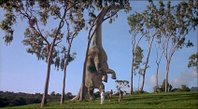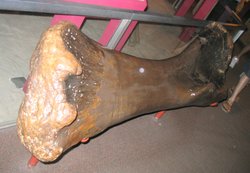Brachiosaurus
For many decades, Brachiosaurus (brack-ee-oh-SORE-us) was the largest dinosaur known. more...
It has since been exceeded in sheer mass by a number of giant titanosaurids like the Argentinosaurus and it was finally surpassed in height by another brachiosaurid, the Sauroposeidon. It was, however, still the largest dinosaur known from a relatively complete skeleton.
However, even that may no longer be true, since the largest known specimens are now considered to be part of the new Giraffatitan genus. This new genus includes the famous mounted Brachiosaurus in the Humboldt Museum of Berlin, which is the tallest mounted skeleton in the world.
Brachiosaurus is estimated to weigh from 30 to 80 tonnes (35 to 90 tons), to reach 13 meters (42 feet) in height, and 25 meters (82 feet) in length. Higher estimates are usually based on the Ultrasauros, which was originally considered to be an extremely large Brachiosaurus. However, Ultrasauros is now believed to be a chimera, composed of neck bones from a Supersaurus, and a shoulder bone (scapulacoracoid) from a Brachiosaurus smaller than the largest Giraffatitan specimens.
Description and environment
Brachiosaurus was a sauropod, one of a group of four-legged, plant-eating dinosaurs with long necks and tails, and tiny brains. Unlike other families of sauropods, it had a giraffe-like build, with long forelimbs and a very long neck, which, as a recent study has proven, it did not raise above its head. It had teeth like chisels (spatulate), and nostrils on the top of its head, which may indicate it had a good sense of smell. It had a number of holes in its skull to reduce weight. The first toe on its front foot, and the first three on its hind feet had claws. They may have traveled in herds.
It used to be theorized that it used the nostrils on the top of its head like a snorkel, and spent most of its time submerged in water to help support its great mass. However, it is now believed that it was a fully terrestrial animal. Studies have shown that the water pressure would be too great for it to breathe while submerged, and its feet are too narrow, and would sink into the mud.
Like all of the other "long-necked" dinosaurs, the Brachiosaurus’ neck was heavy and when it held it in a upright position for too long time, it would not get any blood to the brain. It might have stood at the edge of the forests and waved the head up and down, while it systematically removed all the edible food on the trees.
If the Brachiosaurus was warm-blooded, it is estimated that it would take ten years to reach full size. If it were cold-blooded, then it would take over 100 years to do so. If it were warm-blooded, it would have to eat more than 400 lbs. (200 kg) a day, but a lot less if it were not.
Read more at Wikipedia.org



